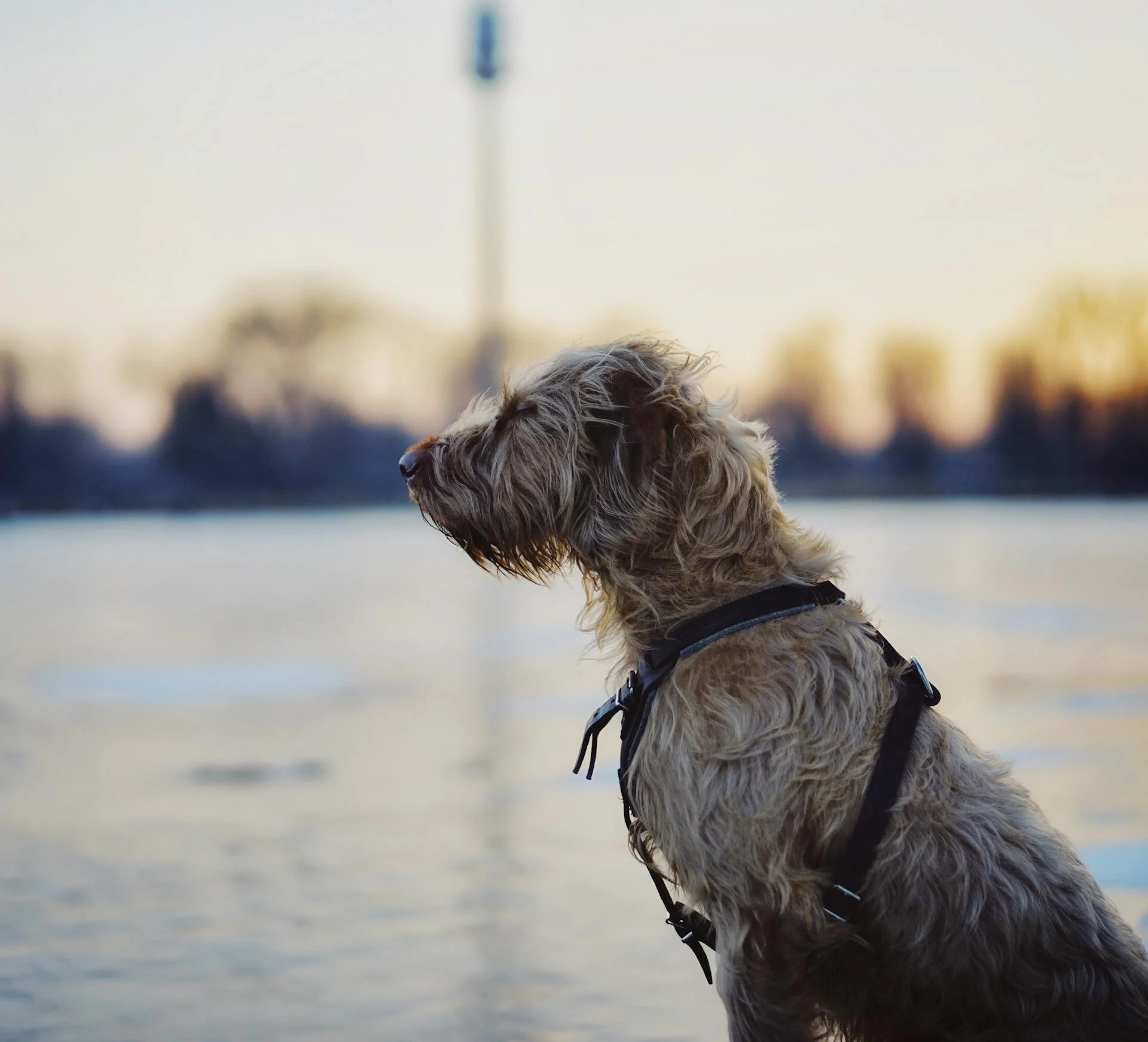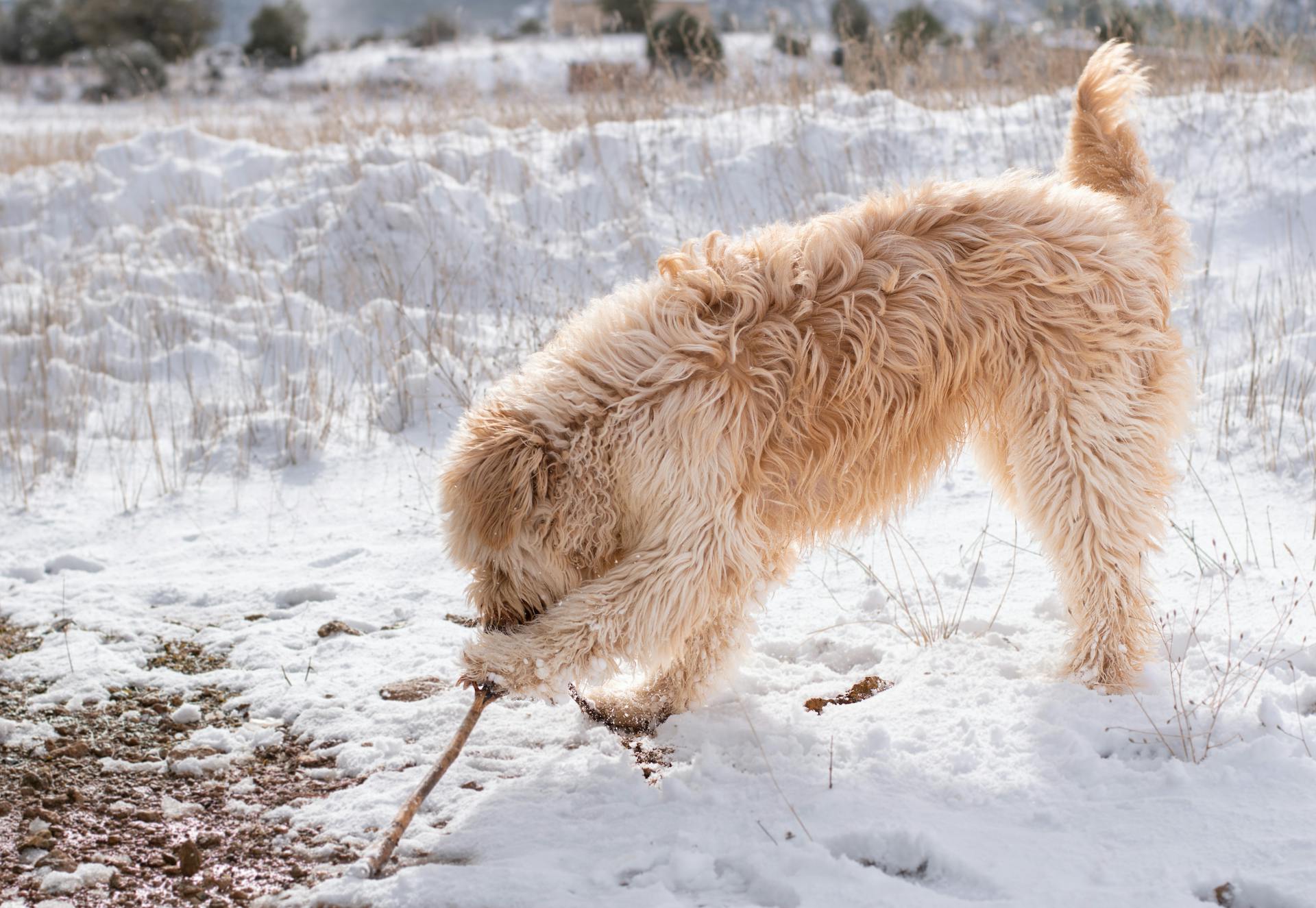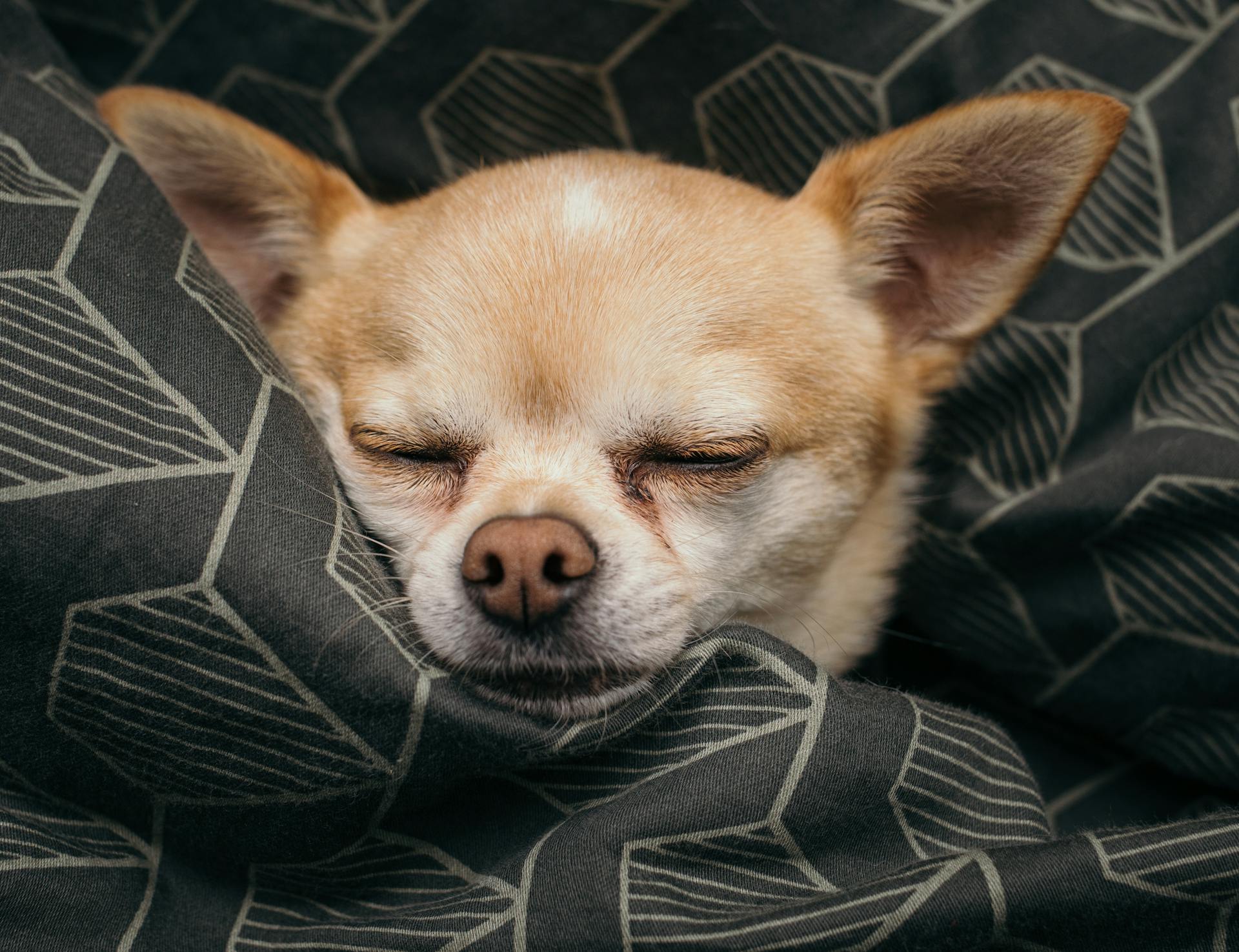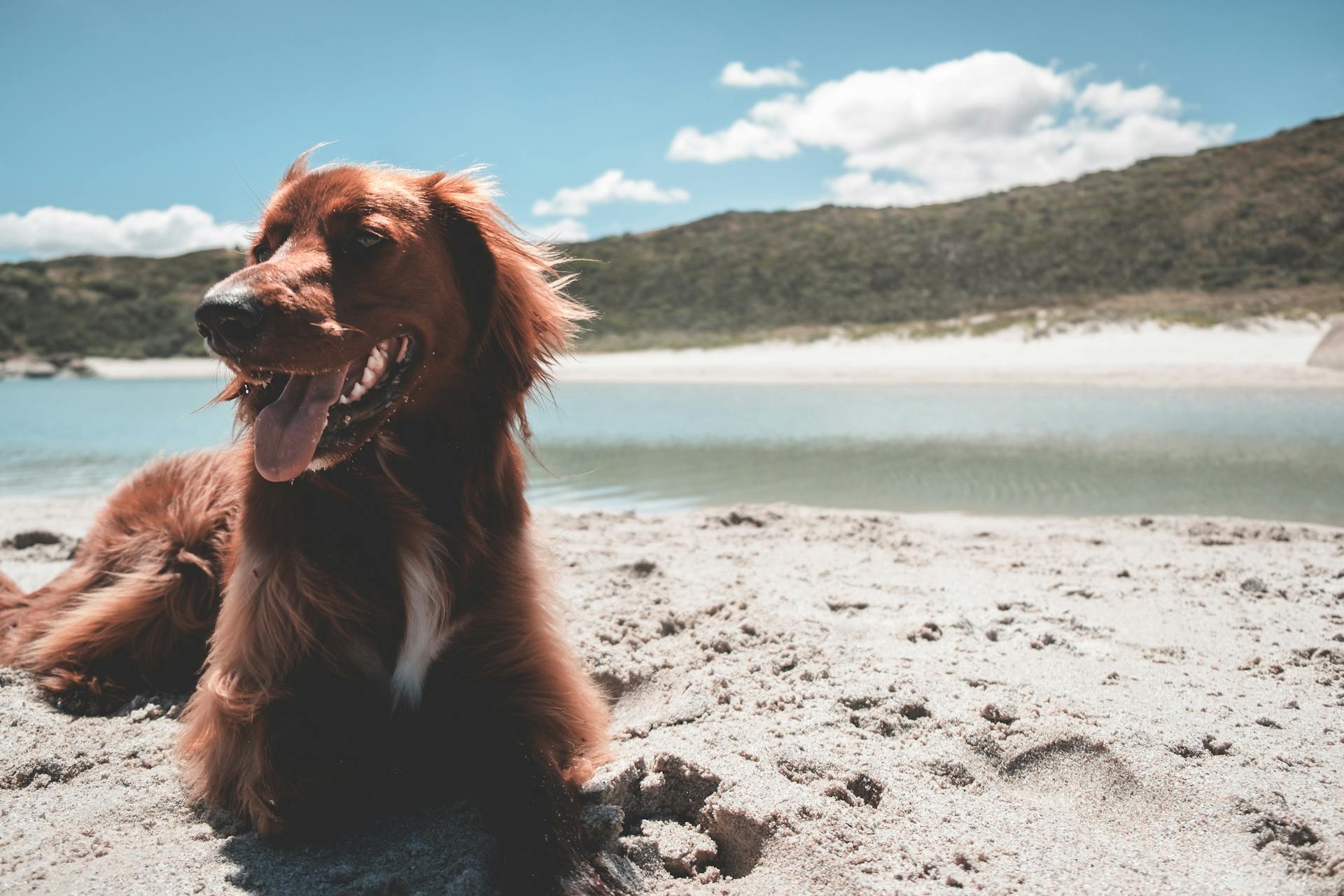
The Irish Wolfhound is an ancient breed with a rich history that dates back over 2,000 years. They originated in Ireland as a hunting companion for kings and nobles.
These gentle giants are known for their distinctive appearance, standing between 30-35 inches (76-89 cm) tall at the shoulder and weighing around 105-180 pounds (48-82 kg). Their short coats come in various colors, including brindle, red, black, and gray.
The Irish Wolfhound is a relatively rare breed, but they're gaining popularity as pets due to their calm and affectionate nature. In fact, they're often described as "big softies" by owners who adore them.
Physical Characteristics
The Irish Wolfhound is a majestic breed with some truly impressive physical characteristics.
They can grow up to 86 centimeters (34 inches) tall, making them one of the tallest dog breeds recognized by the American Kennel Club. The expected range of heights at the withers is indeed between 81-86 centimeters (32-34 inches).
One of the first things you'll notice about an Irish Wolfhound's face is their small ears, which are similar in shape to those of other sighthounds like Whippets or Greyhounds.
Their eyes are dark and often fairly round in shape, giving them a gentle expression that belies their powerful build. The nose of an Irish Wolfhound is also quite distinctive - it's dark and they have a fairly long muzzle.
The coat of an Irish Wolfhound is another notable feature - it's medium length and wiry, with the beard and hair over the eyes particularly wiry. They can come in a range of colors including gray, brindle (faint tiger stripes), red, black, white, and fawn.
Here are some key physical characteristics to keep in mind:
- Height: 81-86 centimeters (32-34 inches)
- Ears: Small and shaped like other sighthounds
- Eye color: Dark, often fairly round in shape
- Nose: Dark, with a fairly long muzzle
- Coat length: Medium length, wiry
- Coat colors: Gray, brindle, red, black, white, fawn
- Tail: Long and curved
The neck of an Irish Wolfhound is muscular and fairly long, and their head is carried high - giving them a commanding presence that's hard to ignore.
Personality
Irish Wolfhounds are known for being kind, loving, and loyal companions, often described as gentle giants.
These dogs have a varied range of personalities and can be quite individualistic, with some having quirky traits that make them stand out. They're generally introverted, intelligent, and reserved in character.
Despite their large size, Irish Wolfhounds are rarely destructive or boisterous in the house, making them easygoing animals that are quiet by nature. They tend to create strong bonds with their family and can become quite attached to both owners and other dogs they're raised with.
However, this attachment also means they can be less adaptable when it comes to new environments or situations, and may even become destructive or morose if left alone for long periods of time. Irish Wolfhounds are bred for independence, which can sometimes make them less keen on defending spaces.
As a result, while they do have a strong instinct to protect their family, they're not typically territorially aggressive towards other domestic dogs. However, when provoked, they can become fierce and fearless in defense of themselves or those they care about.
Irish Wolfhounds are often favored for their loyalty, affection, patience, and devotion, making them wonderful companions for families who appreciate these traits. They respond well to firm but gentle leadership and consistent training, which is essential for bringing out the best in this breed.
Care and Management
The Irish Wolfhound is a big dog, and their size impacts everything from diet to training.
They require lots of time and energy on your part, so make sure to give them plenty of exercise and consistent training and socialization.
Irish Wolfhounds are light shedders, but they do have wiry coats that need regular brushing - at least weekly with a rake brush.
Additional reading: Rhodesian Ridgeback Training
Care
Irish Wolfhounds have a double coat that sheds moderately throughout the year, so you'll need to brush them at least weekly.
Regular brushing will help remove loose fur and debris, keeping their coat healthy and preventing matting. A rake brush is an essential tool for this task, followed by a pin brush to keep their coat in top condition.
You should also plan to bathe your Irish Wolfhound every one to two months, depending on how dirty they get. And don't forget to check their ears at least weekly for any dirt, irritation, or other abnormalities.
If this caught your attention, see: Irish Setter Coat

Irish Wolfhounds typically need their nails trimmed roughly once a month, so be sure to keep an eye on them and trim as needed. Brushing your dog's teeth is also beneficial in preventing dental issues – start when they're puppies to get them used to the feeling, and aim for daily brushing by adulthood.
Notes
The Irish Wolfhound has a rich history that spans centuries and continents. The original historic breed originated in Ireland.
If you're considering getting an Irish Wolfhound as a pet, it's essential to know its origins. While the modern breed was developed in Gloucestershire, England, the historical roots of this magnificent creature lie in the Emerald Isle.
For those interested in exploring more about hound breeds, did you know that there are many types of hounds? Some examples include Anglo-French hounds, Bassets, Coonhounds, Feists, and Lurchers.
Health and Nutrition
Irish Wolfhounds have a relatively short lifespan, with estimates ranging from 4.95 to 9.9 years.
Their health issues can be costly to manage, especially for conditions like bloat and bone cancer. Bloat is a life-threatening emergency that requires surgery, while bone cancer often involves surgery, chemotherapy, and radiation. Dilated cardiomyopathy, another common issue, causes the heart to enlarge and weaken, requiring daily medication.
To keep your Irish Wolfhound healthy, choose a dog food specifically formulated for large breeds, and discuss the variety and amount with your vet. This will help ensure you're meeting their nutritional needs. Feeding smaller meals and using puzzle toys can also prevent bloat by slowing down eating times.
Some common health issues in Irish Wolfhounds include:
- Dilated cardiomyopathy (DCM)
- Bone cancer
- Gastric dilatation-volvulus (bloat)
- Osteochondrosis
Note: This list is not exhaustive, but it highlights some of the most frequently reported diseases in the breed.
Common Health Problems
Irish Wolfhounds have a relatively short lifespan, with a life expectancy of 6-8 years and some health issues to watch out for.
One concern is bloat, which can be fatal if not treated promptly. Bloat occurs when the stomach twists, causing a life-threatening emergency that typically requires surgery to correct.
Discover more: Irish Wolfhound Life Span

Irish Wolfhounds are also prone to liver shunts, an abnormal series of blood vessels that can cause stunted growth, poor muscle development, disorientation, and seizures.
Bone cancer is another issue in this breed, with treatment often including surgery, chemotherapy, and radiation. Hip and elbow dysplasia can also occur, leading to lameness, pain, and arthritis.
Dilated cardiomyopathy (DCM) is a heart condition that causes the heart to enlarge and weaken, requiring daily medication to manage. Irish Wolfhounds are 27.5 times more likely to contract osteogenic sarcoma than other breeds.
Here's a summary of some common health problems in Irish Wolfhounds:
- Bloat: A potentially fatal condition where the stomach twists.
- Heart disease: Irish Wolfhounds are prone to heart conditions like cardiomyopathy and atrial fibrillation.
- Cancer: Bone cancer is more common in this breed, especially at a younger age.
- Liver shunt: A congenital condition that affects the liver's ability to filter blood.
- Hip and elbow dysplasia: Conditions that affect the hips and elbows, causing pain and lameness.
Diet and Nutrition
Always have fresh water available to your dog, and expect a hefty food budget for this big breed.
Most owners feed two measured meals per day, but it's best to choose a dog food specifically formulated for large breeds to meet their nutritional needs. Discuss the variety and amount with your vet, as this can vary based on age, activity level, and other factors.

You should be mindful of treats and extra food to prevent your dog from becoming overweight, which puts too much stress on their joints. This is especially true since Irish wolfhounds are at risk of bloat and potentially life-threatening stomach twists, often arising when a dog eats too quickly.
Feeding smaller meals and restricting activity right after meals can help prevent bloat. Using puzzle toys that slowly dispense food is also an effective way to slow down eating and reduce the risk of bloat.
A complete and balanced diet is essential for supporting healthy growth in Irish wolfhound puppies, but it's also crucial to avoid overfeeding that might cause them to grow too quickly, which puts large and giant breed puppies at risk for musculoskeletal problems in adulthood.
History and Origins
The Irish Wolfhound has a rich history that spans centuries. The breed was honored for its size and stature in Irish folklore, making them excellent companions on quests and battles.
Their origins can be traced back to ancient times when they were bred with Middle Eastern hounds, resulting in a majestic dog. One of the earliest accounts of the breed is from a Roman consul who received seven Irish hounds as a gift in 391 AD.
The Irish Wolfhound was used for hunting big game and was particularly effective at hunting wolves in Ireland during the 15th century. Unfortunately, their effectiveness led to the extinction of wolves in the country by the 1700s, which subsequently led to a decline in the breed's population.
However, with renewed interest in preserving the breed in the mid-1800s, the Irish Wolfhound was saved from extinction. A British army captain played a significant role in standardizing and preserving the breed.
Here are some key dates that highlight the history of the Irish Wolfhound:
- 391 AD: Roman consul receives seven Irish hounds as a gift
- 15th century: Irish Wolfhounds used to hunt wolves in Ireland
- 1700s: Wolves eradicated in Ireland, leading to a decline in the breed's population
- Mid-1800s: British army captain works to preserve and standardize the breed
- 1897: American Kennel Club recognizes the Irish Wolfhound breed
Ownership and Adoption
You can expect to pay around $2,000 for a reputable breeder puppy, though prices may vary depending on bloodline and other factors.
Irish wolfhounds require regular veterinary checkups to ensure their health, which can be expensive due to their large size and the need to eat more than smaller breeds. They also have various health conditions that a good breeder will take steps to prevent.
If an Irish wolfhound sounds like the right breed for you, consider adopting from a local shelter or rescue. The Irish Wolfhound Club of America's national rescue directory could be a good place to start.
Expand your knowledge: Is Irish Setter a Good Boot
Dogs for Adoption/Buy
Considering adopting an Irish Wolfhound? You're not alone - these gentle giants have stolen many hearts.
Irish wolfhounds aren't a common sight at animal shelters, but it's still worth looking into local shelters for a dog in need of a home.
If you do decide to buy from a breeder, be prepared for the initial cost to range around $2,000. This can vary depending on bloodline and other factors.
A reputable breeder will take steps to ensure their puppies are healthy, which may result in higher prices for those dogs. Regular veterinary checkups will also be necessary to keep your Irish wolfhound in top shape.
Discover more: Irish Setter Breeders
Because of their large size, Irish wolfhounds need to eat more than smaller breeds, adding to the overall cost of ownership.
If you're looking to adopt an Irish Wolfhound, consider reaching out to a breed-specific rescue organization like the Irish Wolfhound Club of America Rescue Organization or checking their breeder listing for reputable breeders.
Ideal Owner
As you consider bringing a new furry friend into your life, think about whether you have the space and patience for a massive puppy that will take three years to mature.
You'll need to provide plenty of room indoors and out for this dog to roam, as well as a suitable vehicle to transport them comfortably. Wolfhound puppies should not be over-exercised, but they still need regular outings to get some fresh air and experience the world around them.
Family Suitability
The Irish Wolfhound can be a wonderful family dog if you have older, sensible children who understand how to interact with them safely.

They are quiet and friendly to all and devoted to their family, making them a great addition to many households. However, they are way too big for small children, especially as they can be very bouncy adolescents.
Dogs and young children should never be left alone together, so it's essential to supervise all interactions between them to ensure everyone stays safe. Even with proper supervision, adults must remember that there is nothing out of reach for this giant dog.
Frequently Asked Questions
Are Irish Wolfhounds good house dogs?
Yes, Irish Wolfhounds are well-suited as house dogs due to their loyal and affectionate nature. They thrive on human companionship and enjoy being part of a family.
Why are Irish Wolfhounds so expensive?
Irish Wolfhounds are expensive due to their high demand from reputable breeders who prioritize health, quality, and lineage. The price is influenced by factors such as pedigree, breeding history, and overall dog quality.
Are Irish Wolfhounds the tallest dog?
Yes, Irish Wolfhounds are indeed the tallest dog breed. They stand out not only in height but also for their athletic build.
Sources
- https://be.chewy.com/dog-breed/irish-wolfhound/
- https://en.wikipedia.org/wiki/Irish_Wolfhound
- https://www.thesprucepets.com/irish-wolfhound-dog-breed-profile-4776801
- https://www.purina.co.uk/find-a-pet/dog-breeds/irish-wolfhound
- https://www.thefarmersdog.com/digest/the-irish-wolfhound-breed-guide-history-personality-grooming-training-health-and-feeding/
Featured Images: pexels.com


